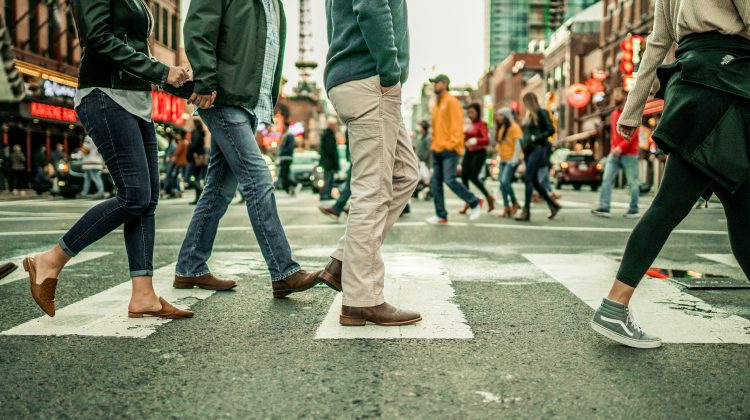Crosswalks are a fundamental part of pedestrian safety, providing designated spaces for individuals to cross the street. However, not all crosswalks are the same, and not all are even visible. Understanding the difference between marked and unmarked crosswalks is essential for both pedestrians and drivers. It also plays a significant role in determining liability in the event of an accident.
What Is a Crosswalk?
A crosswalk is legally defined as a portion of the roadway designated for pedestrian crossing. According to the Manual on Uniform Traffic Control Devices (MUTCD) and state traffic codes, crosswalks can either be marked, with visible lines or signs, or unmarked, which exist by law at most intersections even without any pavement markings.
Marked Crosswalks
A marked crosswalk is one that is clearly delineated on the pavement, often by painted lines, ladder-style striping, or other visual indicators. These crosswalks are commonly found at intersections with traffic lights or stop signs, school zones, or in areas with high pedestrian traffic.
Marked crosswalks offer a strong visual cue, which can help reduce the likelihood of accidents. They also provide critical evidence in a personal injury case, as they reinforce the pedestrian’s right-of-way in most situations.
Unmarked Crosswalks
An unmarked crosswalk is a legal crossing area that lacks visible indicators on the road surface. Most commonly, unmarked crosswalks exist at intersections, where sidewalks on either side continue across the street, even if the roadway is not painted or signed.
Legal Basis
Under the traffic laws of many states, unmarked crosswalks are presumed to exist at all four corners of an intersection, unless pedestrian crossing is explicitly prohibited.
For example, if you are at a residential street intersection without painted lines but with sidewalks, the space between the curbs is legally recognized as a crosswalk, even if drivers may not realize it.
Importance for Pedestrians
While pedestrians have the right-of-way in both marked and unmarked crosswalks, unmarked crossings pose greater safety risks due to:
- Lack of visibility to drivers
- Absence of signage or road signals
- Greater driver confusion about pedestrian rights
Despite these challenges, pedestrians in unmarked crosswalks still have legal protections and may be entitled to compensation if injured by a negligent driver.
Why the Difference Matters
The distinction between marked and unmarked crosswalks has serious legal implications, especially in personal injury cases involving pedestrian accidents.
Liability Considerations
- Marked Crosswalks: These provide strong evidence in the pedestrian’s favor. Drivers are generally presumed liable if they strike someone in a clearly marked crosswalk, particularly when the pedestrian has the walk signal or the right-of-way.
- Unmarked Crosswalks: Proving liability may be more complex. While pedestrians are still protected under the law, drivers often argue that they did not see a designated crossing area or were unaware of the pedestrian’s presence.
In both cases, determining fault often involves reviewing traffic laws, road conditions, eyewitness testimony, and any available surveillance or dashcam footage.
Insurance and Compensation
Injured pedestrians may be eligible to receive compensation for:
- Medical expenses
- Lost wages
- Pain and suffering
- Long-term rehabilitation
- Emotional distress
However, insurance companies may try to reduce or deny claims based on perceived ambiguity about crosswalk legality or right-of-way. This is particularly true in unmarked crosswalk incidents, which is why legal representation is important.
Common Crosswalk Accident Scenarios
Some frequent scenarios and common causes of crosswalk-related accidents include:
- A pedestrian is hit while legally crossing at an unmarked residential intersection.
- A driver fails to yield while turning right at a red light, striking a pedestrian in a marked crosswalk.
- A pedestrian is hit in a school zone crosswalk due to a speeding or distracted driver.
- A vehicle runs a stop sign and enters an intersection with an unmarked crosswalk, injuring someone crossing.
Each of these situations may result in serious injuries and long-term consequences for the pedestrian. Legal representation can help ensure that victims receive fair compensation for their losses.
When to Contact a Personal Injury Lawyer
If you or a loved one has been injured in a crosswalk, whether marked or unmarked, it is essential to consult an experienced Norcross personal injury lawyer as soon as possible. Navigating insurance claims, proving liability, and ensuring you receive fair compensation often requires professional legal guidance.
An experienced attorney can:
- Evaluate your case and determine if you have a viable claim
- Collect evidence such as traffic camera footage and witness statements
- Handle negotiations with insurance companies
- Represent you in court if necessary
Protecting Yourself as a Pedestrian Starts with Knowing Your Rights
While both marked and unmarked crosswalks are legally recognized, their visibility and public awareness differ significantly. Pedestrians should understand their rights in both types of crosswalks, and drivers must exercise caution and yield the right-of-way in accordance with the law.




No Comment